David Cham , Henry Davis , Daniel Obeng-Ofori, Ebenezer Owu
African Regional Post Graduate Programme in Insect Science (ARPPIS) University of Ghana, Legon, P. O. Box LG 59, Ghana
Correspondence to: David Cham , African Regional Post Graduate Programme in Insect Science (ARPPIS) University of Ghana, Legon, P. O. Box LG 59, Ghana.
| Email: |  |
Copyright © 2012 Scientific & Academic Publishing. All Rights Reserved.
Abstract
The papaya mealybug Paracoccus marginatus Williams and Granara De Willink (Hemiptera: Pseudococcidae) has a wide host range and great potential to cause damage to economically important fruits, vegetables, and ornamental plants. It has already caused serious damage to the papaya industry since it invaded Ghana lately in 2009. To determine the host range of this mealybug species, host plants were sampled in 3 districts in the Eastern region and Legon in the Greater Accra region of Ghana. A total of 50 plant species in 20 families were identified as host of P. marginatus, including economically important hosts such as Carica papaya, Manihot esculenta, Mangifera indica, Solanum melongena Citrus sp and Theobroma cacao. Favourite hosts included Carica papaya, Manihot esculenta, Solanum melongena, hibiscus sp, Jathropha sp, Plumeria sp, Abutilon indicum and Adansonia digitata. Three new families, Plumbaginaceae, Bombaceae, and Lythraceae and eight new plant species; Launaea taraxacifolia, Euphorbia heterophylla, Codiacum variegatum, Codiacum aucubaefolium, Securinega virosa, Adansonia digitata, Lagerstroemia indica, and Plumbago auriculata were identified as hosts of P. marginatus. Paracoccus marginatus was also found to co-exist with other mealybug species in some economically important host plants. The wide host range of P. marginatus calls for quick action to be taken in other to reduce its devastating impact on economically important food crops, fruits, and vegetables in Ghana and to prevent its spread to other African countries.
Keywords:
Paracoccus marginatus, Favourite Hosts, Wide Host Range, Eastern Region, Greater Accra Region, Ghana
Cite this paper:
David Cham , Henry Davis , Daniel Obeng-Ofori, Ebenezer Owu , "Host Range of the Newly Invasive Mealybug Species Paracocccus Marginatus Williams and Granara De Willink (Hemiptera: Pseudococcidae) in Two Ecological Zones of Ghana", Research in Zoology , Vol. 1 No. 1, 2011, pp. 1-7. doi: 10.5923/j.zoology.20110101.01.
1. Introduction
The Papaya mealybug Paracoccus marginatus Williams and Granara De Willink (Hemiptera: Pseudococccidae) is a native to Mexico and Central America[1,2]. It invaded Ghana lately in 2009[3]. Due to its invasion, about 85% of all papaya farms in the papaya growing regions which were under cultivation prior to P. marginatus invasion have been devastated thereby shrinking the papaya orchards from 2,500 ha to about 380 ha[4]. In other parts of the world, over 60 species of host plants including some economically important fruits, vegetables and ornamental plants have been recorded as hosts of P. marginatus in 22 plant families [1,2]. It is therefore important to study the host range of this mealybug species in Ghana, especially in the Eastern region where it has already caused serious damage to papaya production, and where mixed cropping is a common practice by most farmers.In the Eastern region of Ghana, most farmers practice mixed cropping with crops such as papaya, cassava, and maize which have all been reported as hosts of the papaya mealybug[5]. Several species of weeds have also been found to be hosts of the papaya mealybug[6]. During preliminary survey lately in June 2010 in the Eastern region of Ghana, several host plants were found to harbour mealybugs that look similar to the papaya mealybug. Interestingly, some of these host plants were found within papaya plantations. In Legon in the Greater Accra region, signs of P. marginatus infestation were also eminent.Understanding of the host range of P. marginatus, would therefore help farmers to adopt good cultural practices such as exclusion of these alternative hosts within and around their farms. In addition, knowing the host range of the papaya mealybug, will aid in biological control by providing information on other alternative host plants to serve as targets. This study was therefore undertaken to establish the host range of P. marginatus in the Eastern and Greater Accra regions of Ghana.
2. Materials and Methods
2.1. Study Area
The study was carried out in the Eastern and Greater Accra regions of Ghana (Figure 1). The Eastern region lies in the forest zone, while most parts of Greater Accra are in the coastal savanna zone[7]. These two regions are involved in the commercial production of papaya[8], one of the major hosts of P. marginatus[1]. The temperature range of between 30 and 35 ℃ in February and March in these regions[7] is ideal for the development of P. marginatus[9]. The Eastern region is noted for its large scale cultivation of cash crops, stable food crops, fruits, and vegetables. Also found in the Eastern region are Botanical gardens such as the Aburi gardens. Greater Accra region on the other hand, is noted for its large scale production of horticultural crops[10]. The University of Ghana, Legon campus, for example, contain different types of ornamentals as well as other horticultural crops.In the Eastern region, the study locations were Suhum-Kraboa-Coaltar, Akuapim South, and West Akim districts (Figure 1). At the Suhum-Kraboa-Coaltar district, the study was carried out at Kraboa and Amedi, while at the Akuapim South district, the study was carried out at Akraman and Nsawam areas. Adeiso was chosen as the study location for the West Akim district. In the Greater Accra region on the other hand, the study was carried out at the University of Ghana, Legon campus, Accra (Figure 1). Within the University, five sites were selected for host range studies. These were; the Botanical garden, University farm, Sinna Garden at the Department of Crop Science, Department of Animal Biology and Conservation Science (DABCS) and Department of Botany. These locations were selected based on the availability of ornamentals and other horticultural crops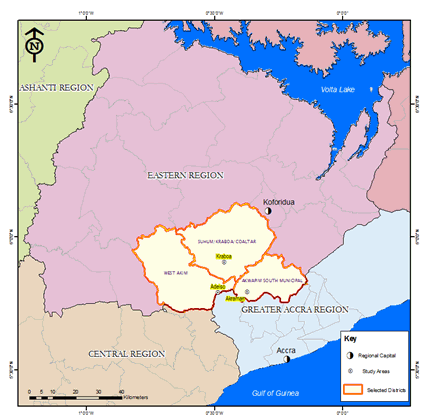 | Figure 1. Map of study regions and sites |
2.2. Sampling and Sorting of Mealybugs and Associated Host Plants
The sampling of mealybugs and associated host plants was carried out from July 2010 to March 2011. In each of the selected sites in the two regions, a systematic sampling technique was used with focus on fruits, vegetables, and ornamental plants including weeds especially on sites located around papaya farms. For each selected plant, a 30 cm long twig was sampled including the reproductive parts in the case of flowering plants (since most mealybug species attack reproductive portions of plants and also to ease the identification of the different host plants) with the use of a sharp knife to prevent damage to the specimens. However, small plants were sampled whole. Each twig was placed in well labeled plastic paper bags containing a collection number, the locality, date of collection, name of collector and notes on the host plant and its habitat. Paper bags containing the different specimens were placed in a large and hard card box to prevent damage to plant parts and/or mealybug specimens and transferred to the ARPPIS laboratory for sorting. Using a camel hair brush, mealybugs were brushed onto a counting tray, counted and recorded. Host plants with high abundance of > 30 adult females per sampling unit in repeated sampling were considered to be the most preferred host plants for P. marginatus. Random samples of mealybugs from the various host plants were later collected into well label vials containing 70% alcohol. Vials containing mealybugs from the same host plant were given the same label as that of the paper bag containing the host plant from which they were collected. All mealybug specimens were transferred to the insect Museum at DABCS, University of Ghana, Legon, while samples of the host plants were transferred to the Herbarium of the department of Botany, University of Ghana for identification.
2.3. Identification of Mealybugs and Associated Host Plants
The following materials were used in the mealybug identification process: alcohol series (70%, 80%, 95%, and absolute), potassium hydroxide (KOH) (10%), acetic acid, acid fusion, clove oil, Canada balsam, distilled water, glass microscope slides and cover glasses (slips). Using a sharp probe, a small incision was made on the side of the abdomen. Mealybug specimens were then cleared by heating in KOH (10%) and later wash-off using distilled water. The body contents were teased out with the help of a small spatula. The specimens were then passed through the following alcohol series; 80%, 95% and absolute alcohol (to remove left over wax) and later, to acetic acid for another 10 minutes. From acetic acid, specimens were soaked in acid fusion for 30 minutes, and then transferred in to clove oil. The specimens were later transferred on to slides and few drops of Canada balsam added. After completion of the mounting process under a dissecting microscope, the slides were dried on a slide warmer and later observed under a microscope. Morphological keys by Miller and Miller[6] were used to distinguish P. marginatus from other mealybug samples. This process of slide preparation for identification was carried out only as a confirmation after using field characteristics, and color change after 24 hours in 70% alcohol as the initial stage in the identification process. In the case of host plants, after taking photos of the fresh samples, the plant specimens were dried with a plant press using the method described by Bowles[11] and later identified in the Herbarium at the department of Botany, University of Ghana, Legon.
3. Results
3.1. Host Range of P. Marginatus in Akraman and Nsawam
A total of 29 plant species in 12 plant families were recorded to be host of P. marginatus in the Akraman and Nsawam areas (Table 1). Of the recorded plant species, 16 (55%) were vegetable, food and fruit crops, belonging to 9 plant families, while 8 (28%) were weeds or wild plants and the rest 5 (17%) were ornamental plants. The family Fabaceae or Leguminaceae recorded the highest numbers of host plants followed by Euphorbiaceae, Solanaceae and Malvaceae, respectively.
3.2. Host Range of P. Marginatus in Krabo and Amedi
In Krabo and Amedi, 26 plant species representing 12 plant families were recorded as hosts of P. marginatus (Table 2). Of these, 15 (58 %) were vegetable, fruit and food crops, 7 (27 %) were weeds and the rest 15 % ornamental plants. The highest number of host plants were recorded in the family Solanaceae followed by Euphorbiaceae and Malvaceae.
3.3. Host Range of P. Marginatus at Adeiso in the South Akim District
At Adeiso, a total of 20 plant species in 8 plant families were recorded as hosts (Table 3). There were 8 individual species of weed hosts (40%), and 8 hosts which were vegetable, fruit and food crops (40%) and four ornamental plants (20%). The highest numbers of host plants were recorded in the family Euphorbiaceae, followed by Malvaceae and Solanaceae. The rest of the families had less than three host plants.
3.4. Host Range of P. Marginatus at Legon in the Greater Accra Region
A total of 39 plant species comprising 16 plant families were recorded (Table 4). Of these, 19 (48.7 %), were ornamental plants, 13 (33.3 %) vegetable, fruit and food crops and 7 (18 %), weeds and wild plants. The family Euphorbiaceae, recorded the highest number of host plants, followed by the family Malvaceae, Leguminaceae or Fabaceae, Apocynaceae and Malvaceae, respectively. The rest of the families had just one or two representatives. Table 1. Host plants and associated families for P. marginatus at Akraman and Nsawam
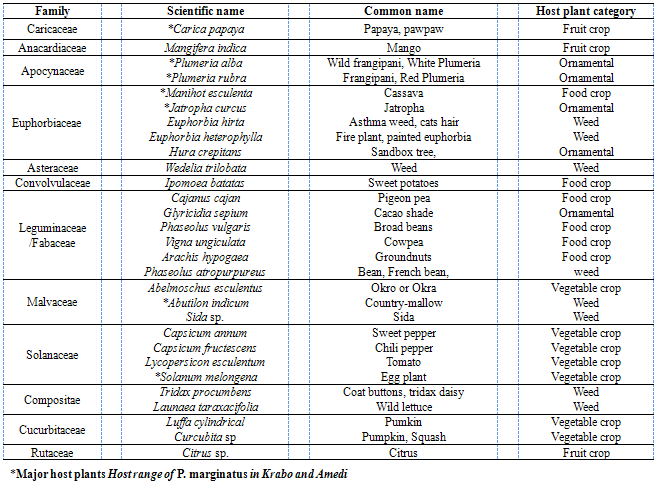 |
| |
|
Table 2. Host plants and associated families for P. marginatus at Krabo and Ameidi areas
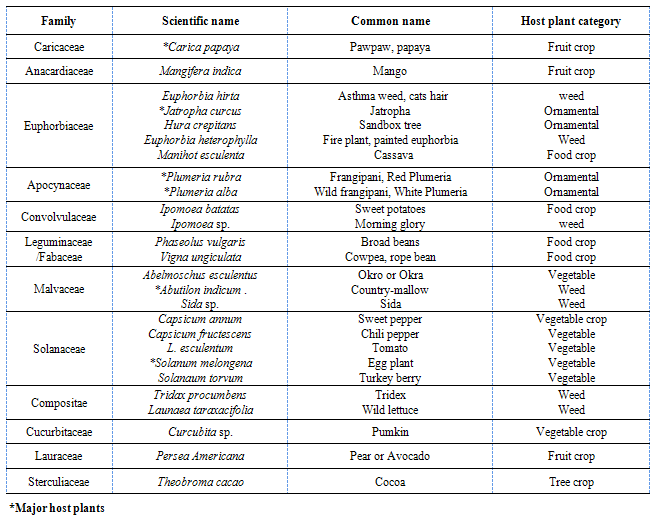 |
| |
|
Table 3. Host plants and associated families for P. marginatus at Adeiso
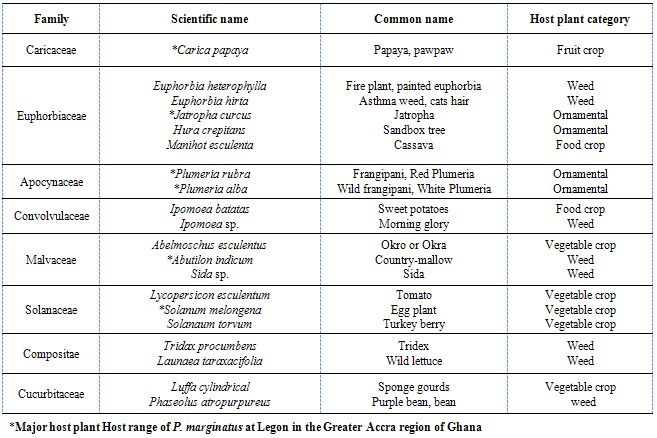 |
| |
|
Table 4. Host plants and associated families for P. marginatus at Legon, University of Ghana campus
 |
| |
|
3.5. Occurrence of P. Marginatus with other Mealybug Species on Some Economic Host Plants
Data on host range studies revealed the co-existence of P. marginatus and other mealybug species such as Pseudococcus longispinus (Targioni Tozzetti), Phenacoccus solani Ferri, Rastrococcus invadens (Green), Phenacoccus manihoti Matile-Ferrero, and Ferrisia virgata (Cockerell) on some important economic crops (Table 5).
4. Discussion
The large host range of P. marginatus at Legon relative to the other sampling sites was probably due to the large number of diverse ornamental plants, which were also recorded as the highest category of host plants in this location. The highest number of vegetable, fruits and food crops serving as host for P. marginatus was recorded in the three districts in the Eastern region of Ghana. The above results were expected since the Eastern region of Ghana is noted for its large scale production of agricultural crops, and Legon for its diverse ornamental plants[7,10]. Overall, four families namely; Euphorbiaceae, Solanaceae, Malvaceae, and Fabaceae or Leguminaceae were found to contain the largest number of host plants. This confirms the findings of several host range studies of P. marginatus[6,12-15]. In Legon, the position of the Solanaceae family was taken over by the family Apocynaceae, with host plants entirely ornamental as opposed to the family Solanaceae which was made up of food crops such as egg plants, tomatoes and sweet pepper. In all the sampling sites in the two regions, the family Euphorbiaceae emerged as the family with the highest number of host plants. Many species of this family are known to produce milky sap containing latex[16]. The family Apocynaceae is also known to contain many latex producing plants[17]. Besides members of these two families, many other plants identified as hosts of P. marginatus were latex containing plants. Examples include C. papaya, A. digitata, I. batatas, and M. indica. The host preference of P. marginatus thus seems to be influenced by the presence of latex. Table 5. Association of P.marginatus and other mealybug species on some economically important host plants
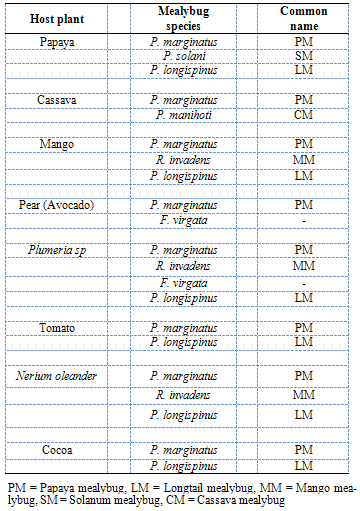 |
| |
|
In general, a total of 50 host plants in 20 families were identified as host of the polyphagous P. marginatus. Earlier studies by Owusu et al.[18] reported over 25 and 26 plants in the Greater Accra and Eastern regions respectively as hosts of mealybugs, with P. marginatus being the most common mealybug species in these locations. However, studies elsewhere have reported P. marginatus to have a host range of over 60 species of host plants, in over 25 families[1,6]. The reason for the low number of host plants, might be that P. marginatus was recently introduced in Ghana and is yet to established itself on other plant species. The host range is likely to increase with increase plant diversity and with time after invasion of an area as P. marginatus become more established. Three families; Plumbaginaceae, Bombaceae, and Lythraceae which were found to contain host plants of P. marginatus, were not found in the literature reviewed. Host plants not also listed in literature but which were found during this study include; Launaea taraxacifolia, Euphorbia heterophylla, Codiacum variegatum, Codiacum aucubaefolium, Securinega virosa, Adansonia digitata, Lagerstroemia indica, and Plumbago auriculata.Results on host preference revealed the following host plants as preferred hosts of P. marginatus; C. papaya, Plumeria sp, S. melongena, J. curcus and J. Multifida, A. digitata, A. indicum, M. esculenta and Hibiscus sp. Meyerdirk et al.[1] listed C. papaya and P. hysterophorus, while Muniappan et al.[2] reported on Euphorbia sp, M. esculenta, I. batatas and C. papaya as being suitable hosts. Caraphin News[13] listed Jatropha sp., Acalypha sp., Hibiscus sp. and A. muricata as being suitable hosts. The findings of this study are vital in term of the management of P. marginatus using Integrated Pest Management (IPM) practices. Abutilon indicum found to be a major host plant of P. marginatus, is a weed, while A. digitata is a wild plant. Jatropha sp. is a common plant in the Eastern region of Ghana used to demarcate boundaries, while M. esculenta is one of the major staple food crops and Plumeria sp. is commonly used as a shade in grave yards. This therefore means weed control alone will not be enough as a control measure for P. marginatus. Since M. esculenta is one of the suitable hosts of P. marginatus, then rapid action is needed to preserve this important staple food crop and to prevent farmers from using chemical control which may eliminate the already present parasitoid, Apoanagyrus (Epidinocarsis) lopezi introduced in the 1990’s against the cassava mealybug, P. manihorti[19]. Biological control of pests on all the major host plants therefore remains the best option. The co-existence of P. marginatus with other mealybug species implies biological control focused only on P. marginatus, might not be the solution. However, most of the other species did not occur on high densities in most of the host plants as P. marginatus since they probably might have established associated natural enemies. This is in line with Owusu et al.[18] who reported high mean occurrences of P. marginatus compared with other mealybug species in both the Eastern and Greater Accra regions of Ghana.
5. Conclusions
Paracoccus marginatus, was found to have a wide host range of over 50 species of host plants in 20 families including economically important fruits, vegetables, and ornamental plants as well as weed host. Three new families; Plumbaginaceae, Bombaceae, and Lythraceae and eight new plant species; Launaea taraxacifolia, Euphorbia heterophylla, Codiacum variegatum, Codiacum aucubaefolium, Securinega virosa, Adansonia digitata, Lagerstroemia indica, and Plumbago auriculata were identified. The host range was thought to be influenced by the presence of latex and it is likely to increase with time as P. marginatus become more established.
ACKNOWLEDGMENTS
The authors thank ARPPIS, Sub-regional centre for West Africa, University of Ghana, Legon for providing the research facilities for this study. We thank Mr. J. Y. Amponsah of the Department of Botany for assistant in host plant identification, and Mr. I. M. Yusif, Extension Officer, Ministry of Food and Agriculture (MOFA), Nsawam for support during survey. Funding was provided by the German Academic Exchange Programme (DAAD) for David Cham.
References
| [1] | Meyerdirk, D. E., Muniappan, R., Warkentin, R., Bamba, J. and Reddy, G. V., 2004, Biological control of the papaya mealybug, Paracoccus marginatus (Hemiptera: Pseudococcidae) in Guam. Plant Protection Quarterly, 19 (3): 110-114 |
| [2] | Muniappan, R., Shepard, B. M., Watson, G. W., Carner, G. R., Sartiami, D., Rauf, A. and Hammig, M. D., 2008, First report of the papaya mealybug, Paracoccus marginatus (Hemiptera: Pseudococcidae), in Indonesia and India. Journal of Agricultural Urban Entomology, 25 (1): 37–40 |
| [3] | Pelican News, 2009, Mealybug hit papaya in Ghana. Blue Skies Newsletter.[Online]. Available: http://www.blueskies.com/newsletter/november09.pdf |
| [4] | IITA Bulletin (2011). IITA, FAO, and PPRSD join forces to save Africa’s papaya. Communication office. http://www.iita.org/c/document_library/get_file?uuid=bcfbf995-7468-41ff-8daa-5b15785bd447&groupId=25357(Accessed: 21/05/2011) |
| [5] | Miller, D. R., Williams, D. J. and Hamon, A. B., 1999, Notes on the new mealybug (Hemiptera: Coccoidea: Pseudococcidae) pest in Florida and the Caribbean: the papaya mealybug, Paracoccus marginatus Williams and Granara de Willink. Insecta Mundi, 13: 179-181 |
| [6] | Miller, G. R. and Miller, G. L., 2002, Redescription of Paracoccus marginatus Williams and Granara De Willink (Hemiptera: Coccoidea: Pseudococcidae), stages and adult male. Proceedings of the Entomological Society of Washington, 104 (1): 1-23 |
| [7] | Modern Ghana, 2010, Eastern region. [Online]. Available: http://www.modernghana.com/GhanaHome/regions/eastern.asp?menu_id=6&menu_id2=14&sub_menu_id=132&gender= |
| [8] | Afreh-Nuamah, K., 2007, Arthropod pests of papaya, Carica papaya- Caricaceae. In: Obeng-Ofori, D. (ed.). Major pests of food and selected fruit and industrial crops in West Africa. City Publishers Ltd, Ghana, pp 127-133 |
| [9] | Amarasekare, K. G., Chong, J., Epsky, N. D. and Mannion, C. M., 2008, Effect of temperature on the life history of the mealybug Paracoccus marginatus (Hemiptera: Pseudococcidae). Journal of Economic Entomology, 101 (6): 1798-1804 |
| [10] | MOFA, 2008, Greater Accra Region (GAR). http://www.mofa.gov.gh/GAR-RADU.html |
| [11] | Bowles, J. M., 2004, Guide to plant collection and identification. [Online]. Available: http://www.uwo.ca/biology/facilities/herbarium/collectingguide.pdf |
| [12] | Meyerdirk, D. E., 1999, Control of the papaya mealybug, Paracoccus marginatus (Homoptera: Pseudococcidae). Environmental assessment. USDA, APHIS, 20 pp |
| [13] | Caraphin News, 2001, Host plants and symptoms of the papaya mealybug in St. Kitts and Nevis. [Online]. Available: http://www.infoagro.net/health/caraphin/newsletters/IICACaraphinNews21.pdf |
| [14] | Narendra-Kumar, J. B. and Shekhar, M. A., 2010, Outbreak of a new invasive pest the papaya mealybug "Paracoccus marginatus" in South India - A serious threat to sericulture industry. [Online]. Available: http://silkwormmori.blogspot.com/2010/10/out-break-of-new-invasive-pest-papaya.html |
| [15] | Tanwar, R. K., Jeyakumar, and Vennila, S., 2010, Papaya mealybug and its management strategies. Technical Bulletin, 22: 1-26 |
| [16] | Hodgkiss, R. J., 2010, Euphorbiaceae–spurges. [Online]. Available: http://www.succulent-plant.com/families/euphorbiaceae.html |
| [17] | Tiwari, S. and Singh, A., 2005, Possibility of using latex extracts of Nerium indicum plant for control of predatory fish Channa punctatus. Asian Fisheries Sciences, 18: 161-173 |
| [18] | Owusu, E. O., Biller, M. K., Davis, E. H., Amponsah, R., Akoto, H. S. and Kettinggbasepa, P., 2011, Report of the technical team on the nationwide survey on mealybug, 42 pp |
| [19] | Neuenschwander, P., 1992, Biological control of cassava mealybug in Africa. In: Markham, H., Wodageneh, A. and Agboola, S. (eds.). Biological control manual volume II. Food and Agriculture Organization of the United Nations, pp. 3-47 |


 Abstract
Abstract Reference
Reference Full-Text PDF
Full-Text PDF Full-Text HTML
Full-Text HTML



